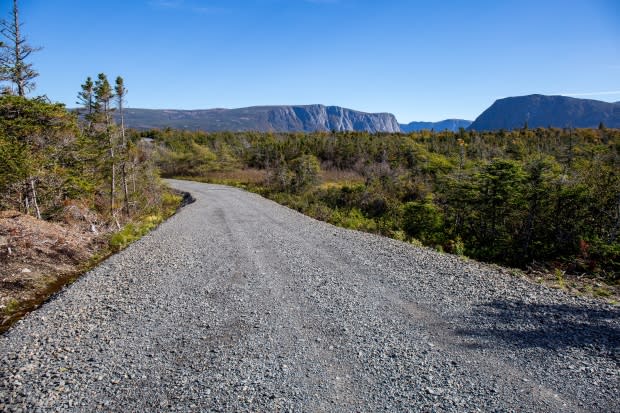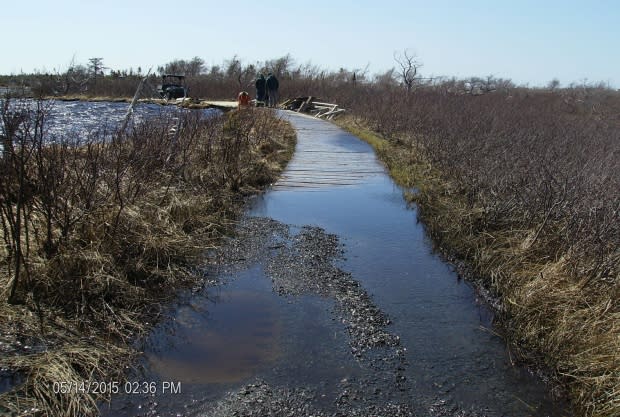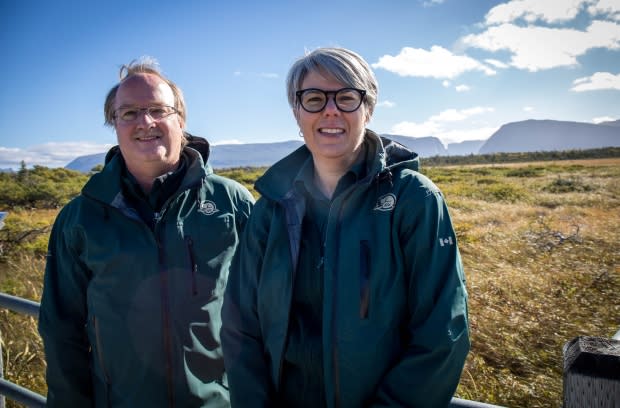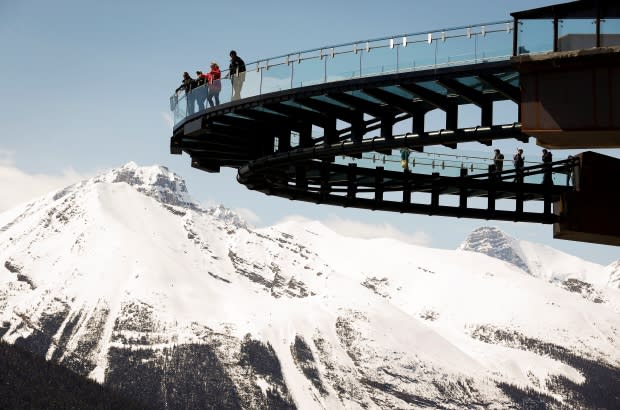How the overhaul of a Gros Morne trail sparked a debate about the purpose of national parks
Parks Canada calls it a trail. Its detractors call it a road.
Without a doubt, it is a controversy that has clouded one of Canada's natural wonders, and the jewel of Gros Morne National Park, since its unveiling in the spring of 2018: the new trail into Western Brook Pond.
The three-kilometre trail — for now, let's call it a walkway — has prompted calls for the park to reverse its development, and serves as a warning for the way in which the parks system as a whole ensures the country's natural spaces are both protected from, and promoted to, its citizens.
"The worst possible thing you can do is run the main attraction of your national park into the ground by over-developing it. You lose it — you kill the goose that laid the golden egg at that point," said Michael Burzynski, who retired from Parks Canada in 2012 after decades working in Gros Morne as an ecosystem scientist.
"That's what we see with this road. It's the beginning of the end for Western Brook Pond as a pristine, isolated, quiet lake."


One popular pond
Western Brook Pond's simple name belies its spectacle. Words that would be subjective applied to almost anywhere else — jaw-dropping, amazing, majestic — become fact when you see this landlocked, freshwater fjord.
Carved from glaciers, snaking 16 kilometres between mountain cliffs taller than the CN Tower, the lake is part of the reason the national park exists, as well as its designation as a UNESCO World Heritage Site. A boat tour, run by a private operator under contract with Parks Canada, glides through its grandeur each May to October.
If any of that sounds like a good reason to check it out, you're not alone.
"It's one of our most visited destinations. We know that two-thirds of our visitors actually do the boat tour," said Rob Hingston, a visitor experience officer with the park.
The ticket sales for the boat tour chart a recent boom in business. In 2013, 23,000 people took the tour; that climbed to 40,000 in 2017. Those numbers reflect a larger trend for all of Gros Morne.
"It's not just here at Western Brook Pond. We see it at the Tablelands, we see it at the Discovery Centre, we see it at the visitors centre. Our camping is up. It's all consistently up," said Hingston.
Trail was 'failing'
The only way for tourists to take the boat tour is via the Western Brook Pond Trail, a walkway that prior to 2018, wound its way from a highway-side parking lot across bogs and ridges in alternating boardwalks and footpaths.
The trail saw in peak season as many as 700 people troop in daily to take the tour, and then troop out, along with untold others simply going in to soak up the pond's five-star view.
"The issue with the trail was really that it was failing, in a lot of ways. Just with the level of use, and the conditions that we're dealing with, we were struggling," said Hingston.
The trail occupied two days a week of trail crew repair time, said another park employee, at the expense of other trail infrastructure, some of which has closed to the public in the meantime due to crumbling conditions.

The trail is one of three in the park designated a Class 1 — meant to be as accessible to as many people as possible — but is often the subject of complaints from people unable to make the trek into the boat tour for numerous mobility reasons.
"We are, through this project, trying to address that concern, because it is something that is communicated to us as a very big issue for many of our visitors to the park," said Carla Wheaton, a visitor experience manager with the park.
Negative reactions galore
"This project" is a neutral term for a something that has been anything but, since its public debut in May.
Beginning in late 2017, the old path was ripped up and replaced with a very wide, straight, crushed-stone surface. Resembling a service road, the new trail makes a beeline to the boat, its former winding ways ironed into submission and its slight elevation gains evened out.
It's also elevated above its surroundings, as part of its design to float on top of the bog, with the vegetation on either side of the trail destroyed during its construction.
Negative reaction rolled in as summer tourism season hit: from tour guides, to disability advocates, to a former director general of Parks Canada.

And of course, from Burzynski himself, who still resides in the nearby town of Rocky Harbour, has written numerous books on Gros Morne, and considers the area almost like an old friend.
"Everything we used to see along the trail — the wild orchids, the insect-eating plants, even some of the geological features that formed these plateau bogs, these very interesting plateau bogs in this area — they're all erased," he said.
"It's like seeing the body of someone who's died, someone who you loved who's died. That's kind of the feeling."
The price for popularity
Those strong feelings prompted a sustained pressure campaign to get Parks Canada to reverse its changes, led by Burzynski and another retired Parks Canada employee, Anne Marceau.
The pair have spent months rebuking the project's rationale, and openly questioning the price the landscape has paid for the pond's popularity.
"You can deal with increasing use by visitors by developing something, like this, or you can be a bit smarter about this, and develop alternative things for those people to do, or capping the use of certain places that are being overused," said Burzynski.

He and other critics have pointed out that there are two other fjord boat tours in Gros Morne, which both leave directly from parking lots.
"Not everybody can get everywhere, if that means a level of development that's inappropriate," said Marceau, who spent 24 of her 34 years with Parks Canada working in Gros Morne as a visitor experience specialist.
"At what cost do we attempt to make it accessible for everybody? And if that means, in this case, accessible for everybody requires a road, it requires a shuttle service, it probably requires more infrastructure at the pond … is that a fair price to pay?"
Parks Canada maintains any adjustments to the trail are meant to address the current level of visitation, and its resulting accessibility issues.
"It's not about trying to increase the numbers visiting Western Brook Pond," said Wheaton.

Mandate under scrutiny
There is another accessibility issue at play: Gros Morne, like all other national parks in the country, has a duty to provide Canadians with a way to get in touch with nature.
"It's important to give Canadians an opportunity to get out and experience nature for a variety of reasons. There are the health benefits of being in nature," said Wheaton.
"There's also the benefit to the national park, in the sense that if people experience a national park, understand and value what it offers society, then they will support national parks."
That even forms a part of Parks Canada's mandate, a guiding document for the federal agency: a commitment to "present the beauty and significance of our natural world."
This is Parks Canada acting as a land developer, almost, rather than a conservation agency. - Michael Burzynski
But that portion of the mandate is superseded by the first plank of the document: "to protect, as a first priority, the natural and cultural heritage of our special places." As Marceau, Burzynski and others have pointed out, that doesn't align with what has happened to the trail.
"This is Parks Canada acting as a land developer, almost, rather than a conservation agency," said Burzynski.
"We hire Parks Canada staff to look after these most important landscapes that we have in the country. They're managers, not developers."
A warning from out west
The trail is far from the first time in recent memory controversy has come calling amid national park development.
The Glacier Skywalk opened in Jasper National Park in 2014, after years of public debate and criticism.
A report from the environmental non-profit Canadian Parks and Wilderness Society called that attraction and others out in public report two years later, saying Parks Canada is putting "an increasing focus on tourism, marketing, increased visitation, supporting non-nature-focused recreational activities, and revenue generation, without adequate attention to the implications this might have for the parks' ecological integrity."

Not all recent national park development proposals have gotten green-lit; in January Parks Canada killed the idea of a bike path between Banff and Jasper, citing ecological concerns as one reason.
Banff and Jasper welcome the most visitors annually of any national park, at about 4.1 million and 2.4 million respectively for the 2017-18 year. Gros Morne is well down the list, attracting a little less than 240,000.
But a fear of "becoming the next Banff" has been bandied about a lot by Western Brook Pond trail critics, and Marceau warns against looking simply at numbers.
"We think we're very small. We think we have a modest level of visitation here. We thought this place was reasonably remote, because you have to walk in three kilometres. But people want to experience these beautiful parts of Canada," she said.
"How do you welcome the world, and welcome them in a way that you're going to continue to be able to do, and not imperil the qualities and the very things they're coming to experience?"
Silver linings, shifting baselines
Staff at Gros Morne are well aware, and wrestling, with these big questions.
As the final phase of work began on the Western Brook Pond trail in the late fall of 2018, so did the process of creating a new, 10-year management plan for the park.
The public meetings have made no secret that increasing visitation is one of the biggest challenges, and opportunities, facing Gros Morne's future, and in those discussions Western Brook Pond has been brought up time and again as a cautionary tale.
To staff, one silver lining to all the outcry has been a dramatic increase in public interest in Gros Morne overall.
"It's highlighted for us the very positive fact that there are a lot of very passionate people out there, supporters of Gros Morne National Park, who are interested in what is happening here," said Wheaton.
"We want Canadians to be interested in our national parks and to value them."

Since the trail controversy exploded, the park has taken steps to be more transparent about development plans, and has issued public bulletins about the construction progress.
At the management plan meetings, the park has floated the idea of electric shuttles — think fancy golf carts — someday servicing the Western Brook Pond boat tour.
Marceau and Burzynski see that as an example of shifting baselines, and how people's short memories may soon forget a Western Brook Pond that was once a place visited only on foot.
"One thing that's really important here is to look before you leap," said Marceau.
"As things go, we forget where we came from. And with more growth, more growth, more growth — and pretty soon that becomes normal."
Read more from CBC Newfoundland and Labrador

